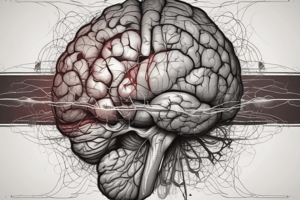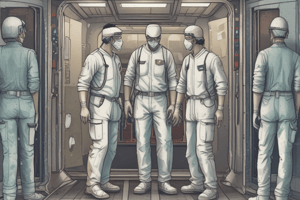Podcast
Questions and Answers
What is a common feature of a fracture?
What is a common feature of a fracture?
- Abnormal motion (correct)
- Bone fusion
- Bone elongation
- Bone thickening
What is a crucial step in assessing a patient with a fracture?
What is a crucial step in assessing a patient with a fracture?
- Only assess the affected limb
- Reexamine all extremities (correct)
- Visually examine the patient's chest
- Document only open injuries
What is the primary goal of immobilization in fracture management?
What is the primary goal of immobilization in fracture management?
- To promote bone growth
- To restore bone function
- To reduce pain
- To include the joint above and below the fracture (correct)
What is a common cause of death in abdominal trauma?
What is a common cause of death in abdominal trauma?
What is a characteristic of maxillofacial trauma?
What is a characteristic of maxillofacial trauma?
Why is the incidence of maxillofacial trauma high despite safety laws?
Why is the incidence of maxillofacial trauma high despite safety laws?
What should the nurse inspect for in maxillofacial trauma?
What should the nurse inspect for in maxillofacial trauma?
What is a critical aspect of managing maxillofacial trauma?
What is a critical aspect of managing maxillofacial trauma?
What is the purpose of reviewing the injury history in fracture management?
What is the purpose of reviewing the injury history in fracture management?
What is a common type of fracture?
What is a common type of fracture?
Flashcards are hidden until you start studying
Study Notes
Mechanism of Injury
- The mechanism of injury refers to the way damage to skin, muscles, organs, and bones occurs
- Types of mechanisms of injury include blunt injury and penetrating injury
Blunt Injury
- Caused by a combination of forces, including acceleration, deceleration, shearing, and crushing
- Examples of blunt injury include MVCs, falls, assaults, and contact sports
Penetrating Injury
- Caused by stab wounds and gunshot wounds, resulting in tissue damage by laceration and tearing
Thoracic Trauma
- Can range from simple to life-threatening, including simple abrasions, contusions, and insults to the thoracic viscera
- Initial assessment and treatment of patients with thoracic trauma consists of primary and secondary surveys
Primary Survey
- First priority is evaluation and stabilization of airways, breathing, and circulation (ABC)
Secondary Survey
- Identification and management of eight potentially lethal injuries:
- Simple pneumothorax
- Hemothorax
- Flail chest
- Pulmonary contusion
- Blunt cardiac injury
- Traumatic aortic disruption
- Traumatic diaphragmatic injury
- Blunt esophageal rupture
Simple Pneumothorax
- Occurs when air enters between the visceral and parietal pleural spaces, often due to lung laceration with air leak
Hemothorax
- Blood accumulation in the pleural cavity, usually less than 1500ml, caused by injury to lung parenchyma, intercostal vessels, or chest wall vessels
Flail Chest and Pulmonary Contusion
- Flail chest: segment of the chest wall does not have bony continuity with the rest of the cage, requiring fracture of 2 or more adjacent ribs in 2 or more locations
- Pulmonary contusion: bruising of the lung parenchyma, often caused by blunt trauma
Blunt Cardiac Injury
- Caused by direct sternal impact or rapid thoracic deceleration, resulting in myocardial muscle contusion, cardiac chamber rupture, coronary artery dissection, and/or thrombosis
Traumatic Aortic Disruption
- Common cause of sudden death after a vehicle collision or fall from a great height
Traumatic Diaphragmatic Injury
- More common on the left side, caused by blunt trauma, producing large radial tears that lead to herniation, while penetrating trauma produces small perforations
Blunt Esophageal Rupture
- Most commonly results from penetrating injury, producing a linear tear in the lower esophagus, allowing leakage into the mediastinum and resulting in mediastinitis and empyema
Abdominal Trauma
- Can be caused by both blunt and penetrating injuries, leading to hemorrhage, shock, and sepsis
- Signs and symptoms may include acute abdomen, increased serum amylase levels, epigastric pain radiating to the back, nausea, and vomiting
Musculoskeletal Injuries
- Common in trauma, with delayed recognition and treatment leading to life-threatening hemorrhage or limb loss
Primary Survey and Resuscitation
- Airway (with cervical spine control)
- Breathing
- Circulation (with control of hemorrhage)
- Disability (neurological condition)
- Exposure (removing patient's clothes)
Hemorrhage Control
- Direct pressure
- Splinting
- Fluid resuscitation
Assessment and Management of Bleeding
- Assess body and extremities for external and internal bleeding
- Check pulse, blood pressure, and skin temperature; pale, weak pulse indicates arterial injury
- Pressure dressing and manual pressure on proximal artery
- Manual tourniquet or pneumatic tourniquet
Adjuncts: Fracture Immobilization
- Method:
- Traction → anatomical position
- Splint
- Check for dislocation
- Goals:
- Hemorrhage control
- Pain relief
- Prevent further soft-tissue injury
Secondary Survey
- History
- Physical examination
Physical Examination
- Look:
- Color of extremities
- Perfusion
- Wounds
- Deformity
- Feel:
- Tenderness
- Neurologic deficits
- Pulses
Circulatory Evaluation
- Palpate distal pulses
- Assess capillary refill
- Doppler
- Coolness and pallor
Limb-Threatening Injuries
- Open fractures and open joint injuries:
- Result from communication between the external environment and the bone or joint
- Risk of infection and delayed healing process
Compartment Syndrome
- Not specified
Vascular Injuries
- Affect arteries and veins of the limbs
- Associated with blunt, crushing, twisting, or penetrating trauma
- May appear viable due to collateral arteries or veins, but can cause cold, pale, and weak pulses
Other Extremity Injuries
- Contusion and laceration:
- Lacerations require debridement and closure
- Contusions recognized by pain, localized swelling, and tenderness
- Fractures:
- Defined as a break in the continuity of the bone cortex
- May include abnormal motion, soft tissue injury, bone crepitus, and pain
- Can be open or closed
- Immobilization must include the joint above and below the fracture
- Assess neurologic and vascular status of the extremity after splinting
Studying That Suits You
Use AI to generate personalized quizzes and flashcards to suit your learning preferences.




